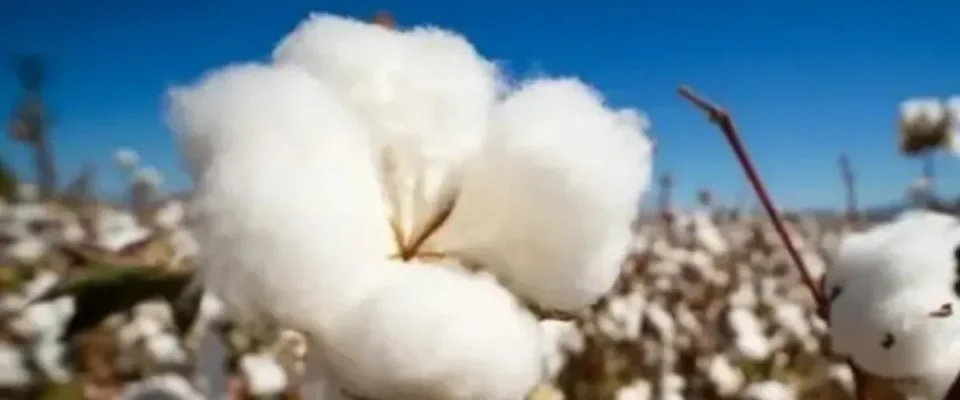The threat posed by climate change to India’s cotton sector can no longer be ignored. As we observe World Cotton Day, there is an urgent need to provide small-scale cotton farmers and the wider cotton industry with the necessary support.
Climate Change and the Future of Cotton :
In the run-up to World Cotton Day last year, one report in particular stood out. Brought out by the International Institute for Environment and Development and the All India Disaster Mitigation Institute, the report found that more than 50 percent of cotton farmers surveyed in Gujarat and Maharashtra suffered significant crop losses due to floods and droughts in the last five years.
With more frequent heatwaves, erratic rainfall, and devastating floods, the very foundation of India’s cotton sector is at risk. Smallholder farmers, who are at the heart of this industry, face mounting uncertainties, while the wider textile supply chain braces for disruptions that could ripple far beyond India’s borders.
The effect manifests in two primary, interrelated dimensions: the erosion of livelihoods for smallholder farmers and a reduction in crop yields, which carries broader repercussions for the nation’s textile sector and subsequently, the global supply chain as well.
In India’s cotton-growing regions, the mean temperature is projected to rise by 1.85°C to 3.95°C under various climate scenarios. This increase could lead to a decline in seed cotton yield by approximately 268 to 477 kg per hectare by the mid-21st century. In rainfed cotton systems across India, climate-induced stressors such as droughts and heatwaves have driven down average yield by 10–15 percent, exacerbating vulnerabilities in a crop that supports millions of smallholders. Projections from Punjab Agricultural University further paint a sobering picture: cotton yields could decline by 11 percent by mid-century (2050), and plummet by up to 24 percent by 2080, relative to current baselines, assuming unchecked warming.
Smallholder farmers, who are at the heart of this industry, face mounting uncertainties, while the wider textile supply chain braces for disruptions that could ripple far beyond India’s borders.
Beyond aggregate losses, these changes disproportionately burden genders in different ways. Men often face direct income erosion from failed harvests, while women grapple with cascading household strains, including diminished access to nutrition, education for children, and overall livelihood security.
The Cost of Climate Change on the Cotton Economy:
Cotton is grown over 13 million hectares of India’s land, making the country the world’s second-largest producer with an output of 29.5 million bales, almost a quarter of the global output. This crop is not just an agricultural staple; it forms the backbone of India’s economy. The Indian textile industry, deeply intertwined with cotton, contributes approximately 2.3 percent to the nation’s GDP, 13 percent to industrial production, and 12 percent to total export earnings.
Given the high stakes of the cotton sector, which is in turn deeply intertwined with the textile industry, India cannot afford to put this vital sector at risk.
The Indian textile and apparel market, valued at US$222.08 billion in 2024, is projected to reach US$646.96 billion by 2033 (at a CAGR of 11.98 percent), driven by exports and e-commerce. The decline in fibre yield caused by climate change could have a significant impact on the textile economy. Given these high stakes, India cannot afford to put its cotton sector at risk.
Given the high stakes of the cotton sector, which is in turn deeply intertwined with the textile industry, India cannot afford to put this vital sector at risk.
Cascading Impacts on the Value Chain:
Because cotton is globally traded, disruptions caused by extreme climate events in major producer countries such as India ripple outwards, affecting international prices and supply chains. The reverse also holds true, adversities in other key regions, including the United States, China, or Brazil, can potentially destabilise India’s domestic market and other sectors. For instance, supply disruptions in cotton can lead to a shortage of raw materials used in the preparation of threads, thereby negatively impacting production in the textile industry.
The impact of climate change is also evident in the financial flows of the cotton supply chain. In Punjab, during 2022, erratic weather and pest outbreaks caused cotton arrivals to local gins to fall by nearly 80 percent, compared to 2021 numbers. With nearly 82 ginning units operating far below capacity, many faced heavy financial losses—factories with annual overheads of INR 35–50 lakh were unable to recover costs as operations stalled.
Private sector partners—such as global apparel brands and retailers—must be engaged to increase funding for sustainability programmes like Regenagri and other climate-focused initiatives aimed at enhancing resilience across the cotton value chain.
The adverse effects are increasingly evident across Asia’s major sourcing and manufacturing hubs. A study by Cornell University’s Global Labor Institute and finance group Schroders projects that the fashion sector could suffer a 22 percent decline in export earnings (around US$65.6 billion) by 2030 due to heat stress and flooding. By 2050, the shortfall could rise to 69 percent, with these key manufacturing centres potentially losing 8–9 million jobs. This sharp decline in supply and profitability underscores how climate-induced yield losses and factory productivity are crippling both livelihoods and the economic stability of the cotton and textile value chain.
Shifting Risk, If Cotton Fades, Carbon Rises:
In the face of escalating climate change-induced disruptions to cotton supply chains, there is an amplified risk of synthetic fibres, which have already captured over 60 percent of the global fibre market, further eroding cotton’s share. Forecasts also predict that synthetics will account for around 70 percent of fibre production by 2030, if disruptions persist in the cotton supply chain. This transition, while potentially stabilising short-term textile supplies, would exacerbate overall climate burdens. Lifecycle analyses show that manufacturing a single polyester T-shirt generates around 5.5 kg of CO₂-equivalent emissions, roughly 2.6 times higher than the 2.1 kg for a comparable cotton garment, due to the use of petroleum-derived feedstocks and energy-intensive processes. Hence, protecting this fibre is imperative and calls for urgent action to build safety nets for smallholder cotton farmers and strengthen the sector’s overall resilience.
Making Cotton Climate-Ready:
Addressing the deepening climate vulnerabilities of India’s cotton sector calls for a multifaceted, multilevel strategy that connects grassroots intervention with high-level investment and policy action, ensuring the protection of yields, rural livelihoods, and the global cotton supply chain.
-
First, it is essential to promote regenerative practices in cotton to significantly restore soil health and enhance resilience to droughts. This includes intercropping, cover cropping, green manuring, mulching, crop residue management, and agroforestry.
-
Second, climate insurance mechanisms for farmers must be strengthened. This can be done by promoting schemes such as the Pradhan Mantri Fasal Bima Yojana (PMFBY) and the Restructured Weather-Based Crop Insurance Scheme (RWBCIS), which offer vital protection against monsoon failure and other climate shocks. By subsidising premiums and using index-based triggers, these programmes enable faster payouts and currently cover millions of smallholders across cotton-growing belts.
-
Third, cotton extension systems in India must also be strengthened. They should use data-driven decision support tools, like Decision Support System for Agrotechnology Transfer (DSSAT) and Agricultural Production Systems sIMulator (APSIM), to provide hyperlocal information for decisions related to adaptive sowing calendars and heat-tolerant crop varieties, helping cotton farmers adapt proactively to warming climate trends. Furthermore, real-time forecasts and agro-advisories can inform irrigation scheduling, pest management, and harvesting decisions.
-
Fourth, active participation of grassroots civil society organizations is needed to support cotton farmers. Such organizations help farmers avail various government schemes like the Pradhan Mantri Krishi Sinchayee Yojana (PMKSY) (promoting efficient water use via micro-irrigation and watershed development to combat drought in cotton fields), and the Kisan Credit Card (KCC) Scheme (providing short-term credit for crop production, including post-harvest storage and marketing loans, at concessional rates).
-
Fifth, the mobilization of climate finance, such as the Green Climate Fund (GCF) and the National Adaptation Fund for Climate Change (NAFCC), to offer opportunities for scaling adaptation investments is imperative.
-
Sixth, ginning units—the first stage of processing after harvest—should proactively engage with local farmers and collaborate with nearby agricultural organizations to manage weather-related risks. The cotton supply chain has a critical role to play. Timely communication on harvesting schedules, weather forecasts, and ginning priorities can ensure smoother operations and greater overall efficiency across the supply chain. In addition, textile manufacturing units should invest in green and sustainable infrastructure designed to maintain lower indoor temperatures and reduce worker fatigue during heatwaves.
-
Finally, private sector partners—such as global apparel brands and retailers—must be engaged to increase funding for sustainability programmes like Regenagri and other climate-focused initiatives aimed at enhancing resilience across the cotton value chain, while aligning India’s cotton economy with international sustainability goals.
News Courtesy : ORF Online

